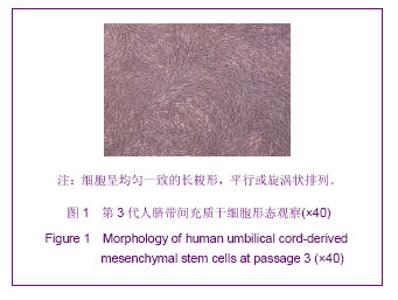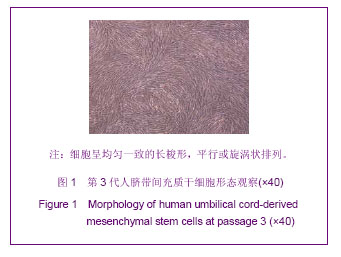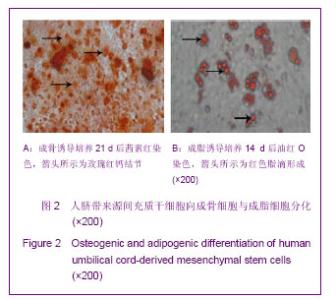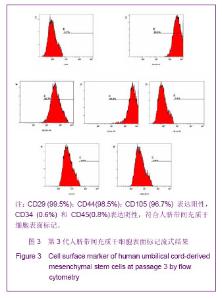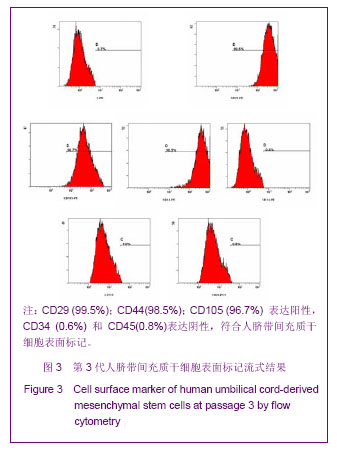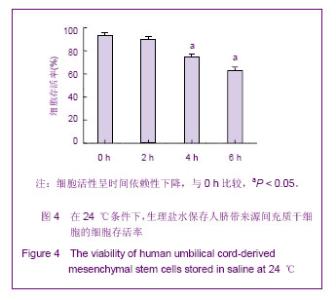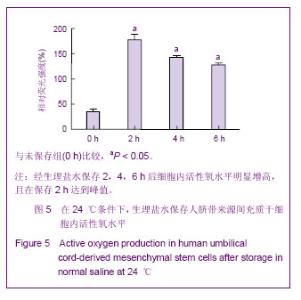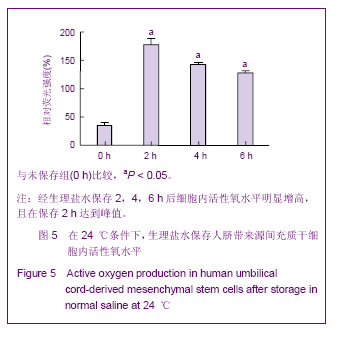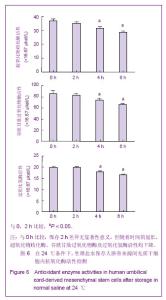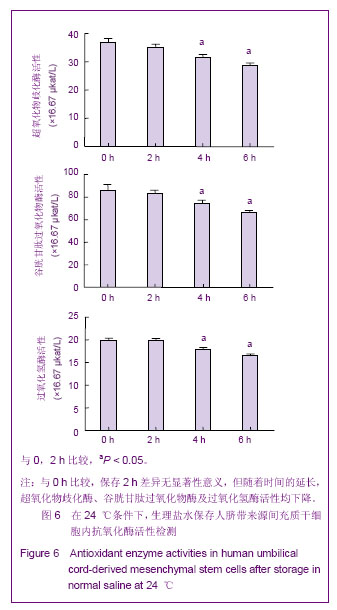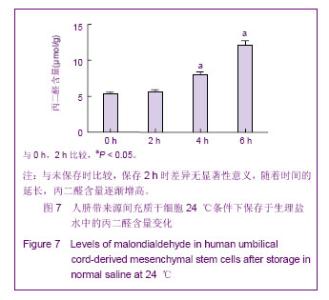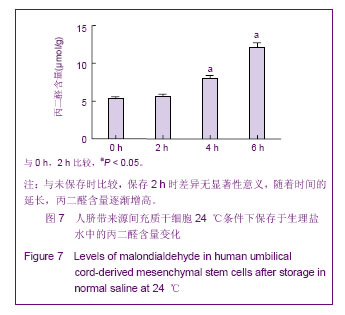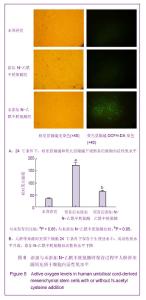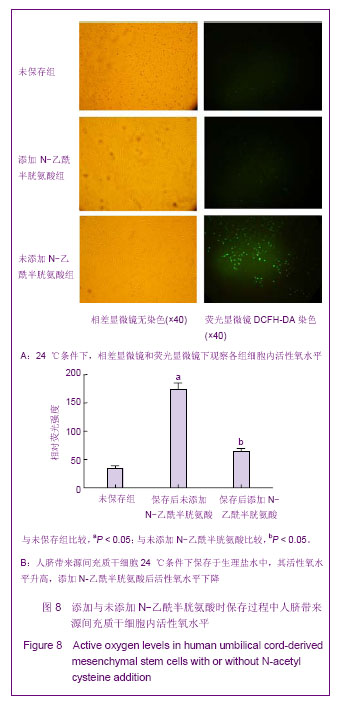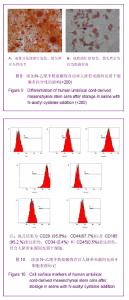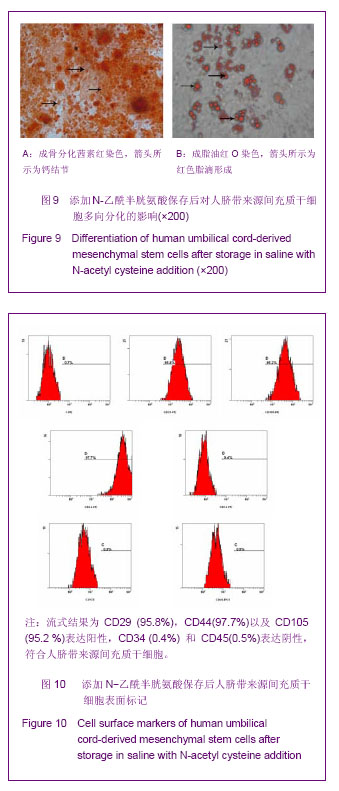Chinese Journal of Tissue Engineering Research ›› 2013, Vol. 17 ›› Issue (32): 5785-5792.doi: 10.3969/j.issn.2095-4344.2013.32.007
Previous Articles Next Articles
Oxidative stress effect on viability of umbilical cord-derived mesenchymal stem cells in storage solution of transplantation
Niu Yu-hu1, Chen Yan2, Zhang Jian-lin1, Lei Xin1, Dong Yan-ting1, Cui Lei2, Niu Bo3
- 1Department of Biochemistry and Molecular Biology, Shanxi Medical University, Taiyuan 030001, Shanxi Province, China
2Department of Respiratory Medicine, the Second Affiliated Hospital of Shanxi Medical University, Taiyuan 030001, Shanxi Province, China
3Department of Biotechnology, Capital Institute of Pediatrics, Beijing 100020, China
-
Received:2012-12-06Revised:2012-12-19Online:2013-08-06Published:2013-08-06 -
Contact:Niu Bo, M.D., Doctoral supervisor, Department of Biotechnology, Capital Institute of Pediatrics, Beijing 100020, China niub2004@126.com -
About author:Niu Yu-hu★, Studying for master’s degree, Department of Biochemistry and Molecular Biology, Shanxi Medical University, Taiyuan 030001, Shanxi Province, China niuyuhu_8905@163.com
CLC Number:
Cite this article
Niu Yu-hu, Chen Yan, Zhang Jian-lin, Lei Xin, Dong Yan-ting, Cui Lei, Niu Bo . Oxidative stress effect on viability of umbilical cord-derived mesenchymal stem cells in storage solution of transplantation[J]. Chinese Journal of Tissue Engineering Research, 2013, 17(32): 5785-5792.
share this article
| [1] Chen Y, Yu B, Xue G, et al. Effects of storage solutions on the viability of human umbilical cord mesenchymal stem cells for transplantation. Cell Transplant. 2012;22(6):1075-1086.[2] Bianco P, Robey PG, Simmons PJ. Mesenchymal stem cells: revisiting history, concepts, and assays. Cell Stem Cell. 2008; 2(4):313-319.[3] Tendera M, Wojakowski W, Ruzy??o W, et al. Intracoronary infusion of bone marrow-derived selected CD34+CXCR4+ cells and non-selected mononuclear cells in patients with acute STEMI and reduced left ventricular ejection fraction: results of randomized, multicentre Myocardial Regeneration by Intracoronary Infusion of Selected Population of Stem Cells in Acute Myocardial Infarction (REGENT) Trial. Eur Heart J. 2009;30(11):1313-1321.[4] Huikuri HV, Kervinen K, Niemelä M, et al. Effects of intracoronary injection of mononuclear bone marrow cells on left ventricular function, arrhythmia risk profile, and restenosis after thrombolytic therapy of acute myocardial infarction. Eur Heart J. 2008;29(22):2723-2732.[5] Wöhrle J, Merkle N, Mailänder V, et al. Results of intracoronary stem cell therapy after acute myocardial infarction. Am J Cardiol. 2010;105(6):804-812.[6] Xiong N, Zhang Z, Huang J, et al. VEGF-expressing human umbilical cord mesenchymal stem cells, an improved therapy strategy for Parkinson's disease. Gene Ther. 2011;18(4): 394-402.[7] Seeger FH, Tonn T, Krzossok N, et al. Cell isolation procedures matter: a comparison of different isolation protocols of bone marrow mononuclear cells used for cell therapy in patients with acute myocardial infarction. Eur Heart J. 2007;28(6):766-772.[8] Pal R, Hanwate M, Jan M, et al. Phenotypic and functional comparison of optimum culture conditions for upscaling of bone marrow-derived mesenchymal stem cells. J Tissue Eng Regen Med. 2009;3(3):163-174.[9] Serigano K, Sakai D, Hiyama A, et al. Effect of cell number on mesenchymal stem cell transplantation in a canine disc degeneration model. J Orthop Res. 2010;28(10):1267-1275.[10] Park SS, Byeon YE, Ryu HH, et al. Comparison of canine umbilical cord blood-derived mesenchymal stem cell transplantation times: Involvement of astrogliosis, inflammation, intracellular actin cytoskeleton pathways, and neurotrophin. Cell Transplant. 2011;20(11-12):1867-1880.[11] Ikehara S. A new bone marrow transplantation method for stem cell disorders. Ann N Y Acad Sci. 2009;1173:774-780.[12] Hermann A, List C, Habisch HJ, et al. Age-dependent neuroectodermal differentiation capacity of human mesenchymal stromal cells: limitations for autologous cell replacement strategies. Cytotherapy. 2010;12(1):17-30.[13] Wang CC, Fang KM, Yang CS, et al. Reactive oxygen species-induced cell death of rat primary astrocytes through mitochondria-mediated mechanism. J Cell Biochem. 2009; 107(5):933-943.[14] Lieberthal W. Macroautophagy: a mechanism for mediating cell death or for promoting cell survival? Kidney Int. 2008; 74(5):555-557.[15] Wochna A, Niemczyk E, Kurono C, et al. A possible role of oxidative stress in the switch mechanism of the cell death mode from apoptosis to necrosis--studies on rho0 cells. Mitochondrion. 2007;7(1-2):119-124.[16] Nehs MA, Lin CI, Kozono DE, et al. Necroptosis is a novel mechanism of radiation-induced cell death in anaplastic thyroid and adrenocortical cancers. Surgery. 2011;150(6): 1032-1039.[17] Folch J, Junyent F, Verdaguer E, et al. Role of cell cycle re-entry in neurons: a common apoptotic mechanism of neuronal cell death. Neurotox Res. 2012;22(3):195-207.[18] Allen CL, Bayraktutan U. Oxidative stress and its role in the pathogenesis of ischaemic stroke. Int J Stroke. 2009;4(6): 461-470.[19] Miyata T, Takizawa S, van Ypersele de Strihou C. Hypoxia. 1. Intracellular sensors for oxygen and oxidative stress: novel therapeutic targets. Am J Physiol Cell Physiol. 2011;300(2): C226-231.[20] Tas S. Genetic predisposition to coronary heart disease and gene for apolipoprotein-CIII. Lancet. 1991;337(8733): 113-114.[21] Klune JR, Tsung A. Molecular biology of liver ischemia/reperfusion injury: established mechanisms and recent advancements. Surg Clin North Am. 2010;90(4): 665-677.[22] 张英,王为,吕国军,等. 体外培养和冷冻保存对微囊化细胞生长和内皮抑素表达的影响[J]. 中国组织工程研究与临床康复, 2008,12(45):8963-8968.[23] 陈国添,张华. 造血干细胞移植中实验室的细胞保存技术[J]. 检验医学与临床,2009,6(20):1766-1768.[24] Ide T, Sunagawa K. ROS and disorder of mitochondrial DNA. Nihon Rinsho. 2007;65 Suppl 4:238-242.[25] Cataldi A. Cell responses to oxidative stressors. Curr Pharm Des. 2010;16(12):1387-1395.[26] Ryter SW, Kim HP, Hoetzel A, et al. Mechanisms of cell death in oxidative stress. Antioxid Redox Signal. 2007;9(1):49-89.[27] Saito Y, Yoshida Y, Akazawa T, et al. Cell death caused by selenium deficiency and protective effect of antioxidants. J Biol Chem. 2003;278(41):39428-39434.[28] Avery SV. Molecular targets of oxidative stress. Biochem J. 2011;434(2):201-210.[29] Iio H, Ake Y, Saegusa Y, et al. The effect of lipid peroxide on osteoblasts and vascular endothelial cells--the possible role of ischemia-reperfusion in the progression of avascular necrosis of the femoral head. Kobe J Med Sci. 1996;42(6): 361-373.[30] 卢文艺,赵明峰,Sajin Rajbhandary,等. 铁过载催化的氧化应激对骨髓间充质干细胞的影响及其作用机制[J]. 中国医学科学院学报, 2013,1:6-12.[31] Sibel Konyalioglu,Guliz Armagan,Ayfer Yalcin,et al. Effects of resveratrol on hydrogen peroxide-induced oxidative stress in embryonic neural stem cells. Neural Regeneration Research. 2013,8(6):485-495.[32] Maheshwari A, Misro MM, Aggarwal A, et al. N-acetyl-L-cysteine modulates multiple signaling pathways to rescue male germ cells from apoptosis induced by chronic hCG administration to rats. Apoptosis. 2012;17(6):551-565.[33] Kim JK, Han M, Nili M. Effects of N-acetyl-L-cysteine on fish hepatoma cells treated with mercury chloride and ionizing radiation. Chemosphere. 2011 Nov;85(10):1635-1638. [34] Ueno T, Yamada M, Igarashi Y, et al. N-acetyl cysteine protects osteoblastic function from oxidative stress. J Biomed Mater Res A. 2011;99(4):523-531.[35] Mitsopoulos P, Suntres ZE. Protective Effects of Liposomal N-Acetylcysteine against Paraquat-Induced Cytotoxicity and Gene Expression. J Toxicol. 2011;2011:808967.[36] Song H, Cha MJ, Song BW, et al. Reactive oxygen species inhibit adhesion of mesenchymal stem cells implanted into ischemic myocardium via interference of focal adhesion complex. Stem Cells. 2010;28(3):555-563.[37] 王延伟,沈肖方,王跃嗣,等.人骨髓间充质干细胞玻璃化冷冻复苏后的生物学活性[J].青岛大学医学院学报,2013,1:33-34.[38] 黄文秋,黄宏,徐祥,等. mTOR及其下游信号通路在骨髓间充质干细胞氧化应激损伤中的变化及作用[J].第三军医大学学报,2013,35(2):114-118. |
| [1] | Pu Rui, Chen Ziyang, Yuan Lingyan. Characteristics and effects of exosomes from different cell sources in cardioprotection [J]. Chinese Journal of Tissue Engineering Research, 2021, 25(在线): 1-. |
| [2] | Zhang Xiumei, Zhai Yunkai, Zhao Jie, Zhao Meng. Research hotspots of organoid models in recent 10 years: a search in domestic and foreign databases [J]. Chinese Journal of Tissue Engineering Research, 2021, 25(8): 1249-1255. |
| [3] | Wang Zhengdong, Huang Na, Chen Jingxian, Zheng Zuobing, Hu Xinyu, Li Mei, Su Xiao, Su Xuesen, Yan Nan. Inhibitory effects of sodium butyrate on microglial activation and expression of inflammatory factors induced by fluorosis [J]. Chinese Journal of Tissue Engineering Research, 2021, 25(7): 1075-1080. |
| [4] | Wang Xianyao, Guan Yalin, Liu Zhongshan. Strategies for improving the therapeutic efficacy of mesenchymal stem cells in the treatment of nonhealing wounds [J]. Chinese Journal of Tissue Engineering Research, 2021, 25(7): 1081-1087. |
| [5] | Liao Chengcheng, An Jiaxing, Tan Zhangxue, Wang Qian, Liu Jianguo. Therapeutic target and application prospects of oral squamous cell carcinoma stem cells [J]. Chinese Journal of Tissue Engineering Research, 2021, 25(7): 1096-1103. |
| [6] | Xie Wenjia, Xia Tianjiao, Zhou Qingyun, Liu Yujia, Gu Xiaoping. Role of microglia-mediated neuronal injury in neurodegenerative diseases [J]. Chinese Journal of Tissue Engineering Research, 2021, 25(7): 1109-1115. |
| [7] | Li Shanshan, Guo Xiaoxiao, You Ran, Yang Xiufen, Zhao Lu, Chen Xi, Wang Yanling. Photoreceptor cell replacement therapy for retinal degeneration diseases [J]. Chinese Journal of Tissue Engineering Research, 2021, 25(7): 1116-1121. |
| [8] | Jiao Hui, Zhang Yining, Song Yuqing, Lin Yu, Wang Xiuli. Advances in research and application of breast cancer organoids [J]. Chinese Journal of Tissue Engineering Research, 2021, 25(7): 1122-1128. |
| [9] | Wang Shiqi, Zhang Jinsheng. Effects of Chinese medicine on proliferation, differentiation and aging of bone marrow mesenchymal stem cells regulating ischemia-hypoxia microenvironment [J]. Chinese Journal of Tissue Engineering Research, 2021, 25(7): 1129-1134. |
| [10] | Zeng Yanhua, Hao Yanlei. In vitro culture and purification of Schwann cells: a systematic review [J]. Chinese Journal of Tissue Engineering Research, 2021, 25(7): 1135-1141. |
| [11] | Kong Desheng, He Jingjing, Feng Baofeng, Guo Ruiyun, Asiamah Ernest Amponsah, Lü Fei, Zhang Shuhan, Zhang Xiaolin, Ma Jun, Cui Huixian. Efficacy of mesenchymal stem cells in the spinal cord injury of large animal models: a meta-analysis [J]. Chinese Journal of Tissue Engineering Research, 2021, 25(7): 1142-1148. |
| [12] | Hou Jingying, Yu Menglei, Guo Tianzhu, Long Huibao, Wu Hao. Hypoxia preconditioning promotes bone marrow mesenchymal stem cells survival and vascularization through the activation of HIF-1α/MALAT1/VEGFA pathway [J]. Chinese Journal of Tissue Engineering Research, 2021, 25(7): 985-990. |
| [13] | Shi Yangyang, Qin Yingfei, Wu Fuling, He Xiao, Zhang Xuejing. Pretreatment of placental mesenchymal stem cells to prevent bronchiolitis in mice [J]. Chinese Journal of Tissue Engineering Research, 2021, 25(7): 991-995. |
| [14] | Liang Xueqi, Guo Lijiao, Chen Hejie, Wu Jie, Sun Yaqi, Xing Zhikun, Zou Hailiang, Chen Xueling, Wu Xiangwei. Alveolar echinococcosis protoscolices inhibits the differentiation of bone marrow mesenchymal stem cells into fibroblasts [J]. Chinese Journal of Tissue Engineering Research, 2021, 25(7): 996-1001. |
| [15] | Fan Quanbao, Luo Huina, Wang Bingyun, Chen Shengfeng, Cui Lianxu, Jiang Wenkang, Zhao Mingming, Wang Jingjing, Luo Dongzhang, Chen Zhisheng, Bai Yinshan, Liu Canying, Zhang Hui. Biological characteristics of canine adipose-derived mesenchymal stem cells cultured in hypoxia [J]. Chinese Journal of Tissue Engineering Research, 2021, 25(7): 1002-1007. |
| Viewed | ||||||
|
Full text |
|
|||||
|
Abstract |
|
|||||
